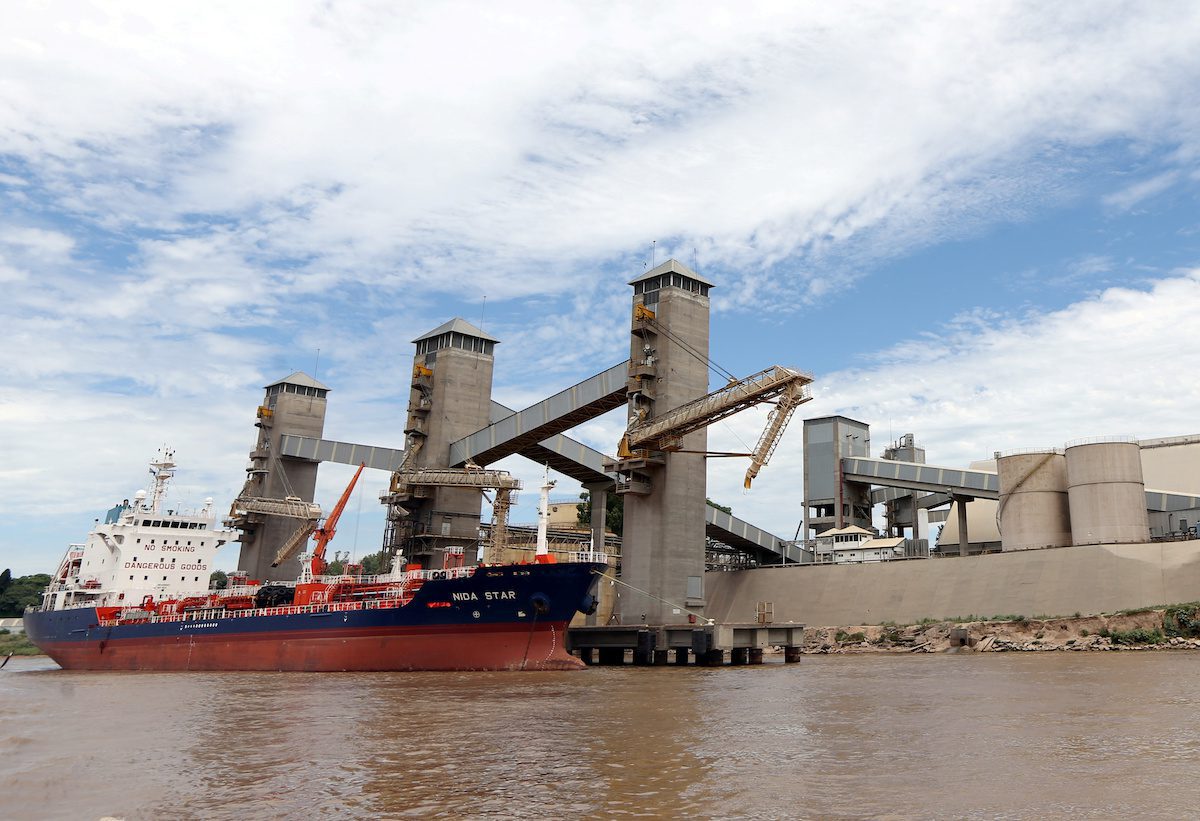FILE PHOTO: Grain is loaded aboard ships on a port on the Parana river near Rosario, Argentina, January 31, 2017. REUTERS/Marcos Brindicci/File Photo

By Hugh Bronstein and Maximilian Heath BUENOS AIRES, May 28 (Reuters) – Shallow water in Argentina’s Parana River will slow exports from the grains powerhouse and hurt the country’s soy crushing margins at least through September, officials said, as more cargo ships are needed to carry the same amount of commodities.
Drought has pushed the Parana to its lowest level in decades, complicating transportation and soymeal production. Some ships are running aground.
Higher costs are pressuring margins at the giant soy crushing plants that make Argentina the world’s top exporter of livestock feed, used to fatten hogs and poultry from Southeast Asia to Europe.
“The Parana is at its lowest level in 50 years. This prevents normal navigation and limits the amount of cargo that can be carried by ships, which adds to costs,” said Omar Perotti, governor of Santa Fe province. Santa Fe is home to Argentina’s main grains hub of Rosario, on the banks of the Parana.
The situation is not expected to improve until September, he said, reflecting a growing consensus among weather experts. Transport problems in Argentina can throw off world trade flows as impatient buyers look to rival exporters Brazil and the United States to fill temporary supply gaps.
While the problem makes soy crushing in Argentina more expensive, global agro-industrial companies with operations in the country, like U.S.-based Bunge, can compensate by way of increased margins in other parts of the world.
“Argentina’s competitiveness is being hurt right now by higher freight costs due to the low water level of the Parana River, and that looks like it’s going to persist for a while,” Bunge CEO Greg Heckman said on an earnings call this month.
“And generally, when Argentina is lower on volume, that’s better for our global crush margins.”
Rosario is home to some of the biggest soymeal factories in the world. They crush beans from Argentina and neighboring Paraguay, the world’s No. 4 exporter of the oilseed. But the river’s shallowness has delayed the arrival of barges from Paraguay.
Failure to receive Paraguayan soy on time generates delays in processing the bean and complicates compliance with international contracts, the Rosario grains exchange said in a recent report.
The latest data from Argentina’s Coast Guard show the Parana’s level at Rosario at 0.82 meters, on a scale in which zero is a reference point rather than the actual depth of the waterway. The normal median level for May is 3.68 meters.
The level of the Parana is unlikely to recover until southern hemisphere spring rains start to hit the tri-border area of Argentina, Brazil, and Paraguay about three months from now, said local meteorologist Leonardo De Benedictis.
“There are limited rains that might help increase the height of the river temporarily but the real solution will not start arriving until September-October, when the rainy season in Brazil begins to re-establish itself,” Benedictis said.
“It usually takes 10 days to two weeks from the start of the rains in the basin where the river starts before you see an increase in water levels downstream,” he said.
(Reporting by Hugh Bronstein and Maximilian Heath, additional reporting by Karl Plume in Chicago, Editing by Rosalba O’Brien)
(c) Copyright Thomson Reuters 2019.

 Join The Club
Join The Club











